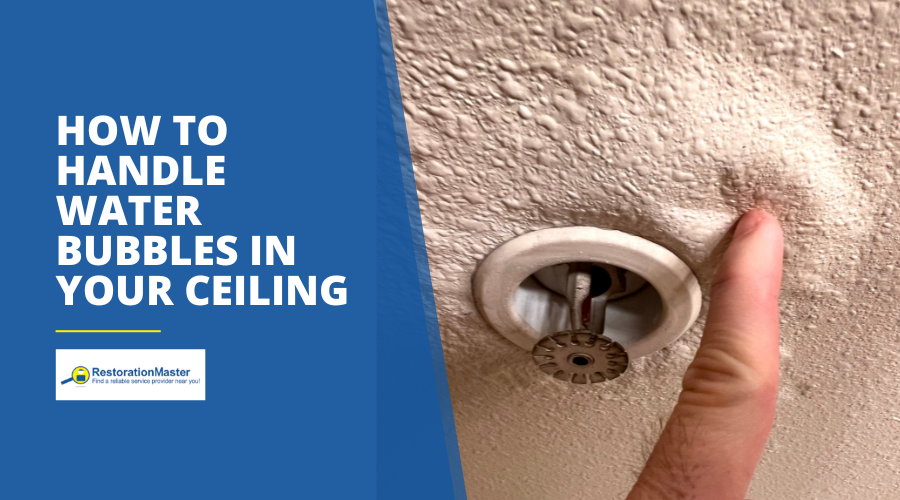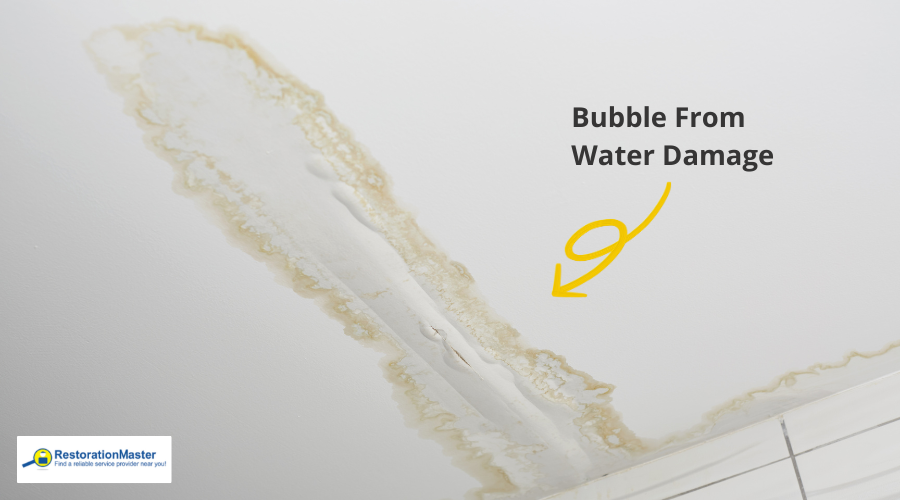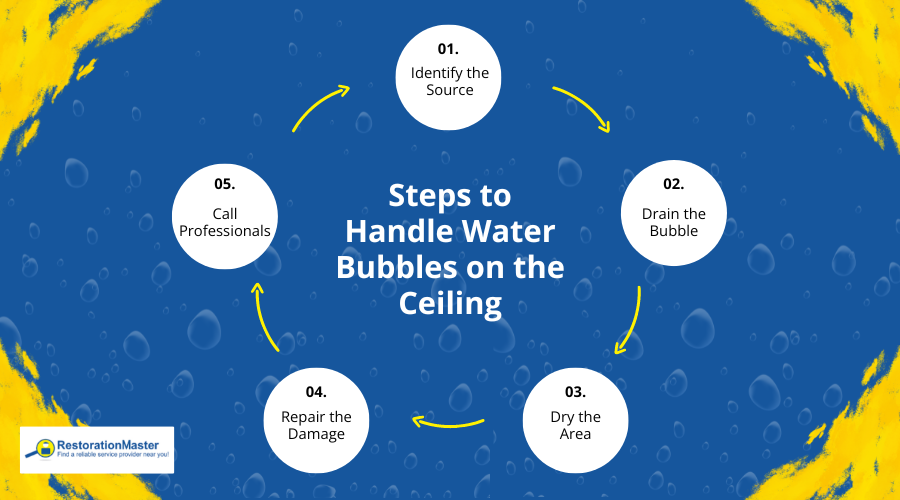How to Handle Water Bubbles In Your Ceiling

Water damage can unexpectedly happen in several ways, from cracks in walls and foundations to moldy floors and water bubbles. Not only do these issues leave hideous damage, but they can also weaken the building’s structureStructure refers to the framework or components of a buildin... More. When water seeps through the roof or a pipe above the ceiling, it can cause significant harm, often seen as a water bubble on the ceiling.
If you notice water accumulating, it is essential to reach out to a professional water damage restoration company, as it signals the vulnerability of structural integrity. While waiting for help to arrive, there are a few immediate actions you can take.
Why Do Water Bubbles Form on The Ceiling?
Water bubbles form on the ceiling as a result of water accumulation between the ceiling material and the surface beneath it. Typically, water bubbles develop from water damage caused by various factors. This is a severe form of water damage that needs to be addressed promptly.
It can happen due to many different reasons:
- Water Leaks: The most common cause of water bubbles is from a leak in the roof, plumbing, or upper floor. When the water leaks, water seeps through the ceiling material.
- AbsorptionAbsorption is the process by which a material takes in or so... More and SaturationSaturation is the point at which a material or environment c... More: As ceiling materials absorb water, they become more saturated. This causes the material to swell and weaken, compromising the structural integrity.
- Trapped Water: Without anywhere for the water to go, it will pool in one area and create a bubble. The materials in the ceiling act as a barrier, trapping the water beneath the surface.
- Low-Quality Paint or PlasterPlaster is a building material made of lime, gypsum, or ceme... More: Paint or plasterPlaster is a building material made of lime, gypsum, or ceme... More that is not waterproof lacks the durability and water resistance of higher-quality materials. A weaker barrier increases the likelihood of absorbing moisture.
- Improper PreparationPreparation is the steps taken to ready a property, equipmen... More Before Painting: The paint should be applied to a completely smooth and drywall. If there is any dirt, dust, or grease on the ceiling surface, this prevents the paint from adhering properly. When a leaking situation occurs, water will pile up, get logged in one area, and drop down to the ceiling.
If water collects above the ceiling, it causes the building materials to separate, resulting in a visual bubble. It is important to address the issue quickly, as it is often an early sign of extensive water damage.

How Can I Tell If The Water Bubble Is Serious?
To determine the severity of a water bubble on the ceiling, several factors need to be assessed. The first step is to identify the size of the water bubble. If the water bubble is small, it may indicate a minor leak that could be addressed with a simple repairRepair is the act of fixing or restoring damaged property, m... More. Larger water bubbles can be an early sign of extensive water damage, as they are usually a result of a substantial leak.
Next, the areas need to be checked for mold growth. Although moldMold is a type of fungus that grows in damp or humid conditi... More growth can occur within the ceiling materials, checking for signs of visible moldMold is a type of fungus that grows in damp or humid conditi... More is an important step. If moldMold is a type of fungus that grows in damp or humid conditi... More sporesSpores are microscopic reproductive units of fungi or mold t... More are present, it can indicate prolonged water exposure and pose health risks, as moldMold is a type of fungus that grows in damp or humid conditi... More often is a result of water damage.
Finally, the source of the leak should be identified. If the source has been addressed, the damage be less severe. On the other hand, an unknown source can indicate a more serious issue that requires professional investigation.
If you conduct these steps and still have a hard time determining the severity of water damage, it is always best to consult with a professional water damage restorationWater damage restoration is the professional process of clea... More expert.
Steps to Handle Water Bubbles on the Ceiling

1. Identify the Source
Whenever you experience a water damage issue, you should first detect the source of the water and stop the influx. You should then contact professional water damage restorationWater damage restoration is the professional process of clea... More technicians immediately for emergency dry-out services to prevent water from spreading into porousPorous describes a material that contains small openings or ... More building materials and furnishings. The more bubbles emerge on your ceiling, the more pressure it places on your plasterPlaster is a building material made of lime, gypsum, or ceme... More, potentially leading to a collapse.
2. Drain the Bubble
After identifying the source of the water damage, grab a large bucket and place it underneath the water bubble. Carefully puncture it with a small sharp object, and allow the water to drain into a container. Be cautious as this step could leadLead is a heavy metal that can be toxic to humans, especiall... More to further damage if not done correctly.
If you are uncomfortable with draining the bubble yourself, call the professionals to remove it.
3. Thoroughly Dry the Area
It is imperative to thoroughly dry the area to prevent further damage such as moldMold is a type of fungus that grows in damp or humid conditi... More growth or weakened building materials. Use fans or a dehumidifierA dehumidifier is a device that removes excess moisture from... More to help dry out the affected area. Ensuring there is proper ventilationVentilation is the process of exchanging or circulating air ... More is important for the drying process.
4. Repair the Damage
Water damage can impact a variety of materials and surfaces in buildings. Checking and repairing some of the following materials is recommended to prevent moisture buildup.
- Brick Skirting: If the water hasn’t been absorbed by all the wall panels, you’re still safe and don’t have to worry.
- Painted Wall: You can try to limit deterioration by using high-pressure sodium lights to shine upon the ceiling.
- Wood-Paneled Wall: There’s no other option but to remove and clean the wooden wall and cover it again.
- Wall Decals: If the old decal layer is unavoidably damaged; it should be removed and cleared up.
- Laminate FlooringLaminate flooring is a type of flooring made of multiple lay... More: Laminate flooringLaminate flooring is a type of flooring made of multiple lay... More typically has poor moisture resistance. The wood will be retracted when it encounters flooding. In that case, you should have the boards removed, cleaned, and re-paved.
- Natural Wood Flooring: Natural wood is more resistant to moisture. However, it doesn’t protect it from water damage. You should lightly dry the wet area with a towel.
5. Call Professionals
The cost of self-troubleshooting can end up two or three times more expensive than restorationRestoration is the process of returning a property to its pr... More services. Most insurance carriers would cover house restorationRestoration is the process of returning a property to its pr... More fees; a trusted restorationRestoration is the process of returning a property to its pr... More company can assist you with filing a claim and work with the provider on your behalf. Do not hesitate to call a water damage restoration professional in your region if your home or business is affected by water damage or floodingFlooding is the overflow or accumulation of water in areas t... More. RestorationMaster’s IICRC-certified technicians will provide emergency cleanup and dryingDrying is the process of removing moisture from materials, s... More to remove the excess water and restore your property to its pre-loss state.
Things to Avoid With a Water Bubble
Although it is recommended to call professional water damage experts to drain water bubbles, there are some important tips to follow to prevent further damage. The most important tip is to not pop the water bubble if you are unaware of the water source.
It is also suggested that large bubbles should not be popped without professional assistance to prevent further damage. RestorationRestoration is the process of returning a property to its pr... More specialists can fully dehydrate the affected areas and structural materials by strategically using advanced extraction equipment to create airflow. It is critical to implement the appropriate dehumidification process to prevent moldMold is a type of fungus that grows in damp or humid conditi... More growth.
Contacting the professionals to restore your property will save you a significant amount of time and money instead of going through the struggle and resolving the problem yourself.
How Can I Prevent Water Bubbles on The Ceiling?
Dealing with a water-damaged ceiling can be a real headache. Therefore, it’s better to be cautious and take preventive action instead of hustling through the complication and attempting to fix the damage. There are several methods to mitigateTo mitigate is to reduce or limit the severity of damage, ri... More the effect when water damage happens, but the two simplest available options are:
- Ceiling Waterproof Stickers: Ceiling waterproofingWaterproofing is the application of materials or coatings de... More stickers, also known as self-adhesive waterproofingWaterproofing is the application of materials or coatings de... More membranes, are one of the materials that are common for waterproofingWaterproofing is the application of materials or coatings de... More. They’re effective and affordable. The process is straightforward. Directly apply them to the area having ceiling cracks to prevent rainwater from entering. There is no need for high technology, but you should choose the best stickers on the market to avoid the problem of ceiling seepageSeepage is the slow movement of water or other fluids throug... More.
- Ceiling WaterproofingWaterproofing is the application of materials or coatings de... More With Sika: Waterproof sika or sika latexLatex is a natural or synthetic rubber material commonly use... More is a kind of waterproof material with additives. Sika can waterproof civil, industrial, and factory construction including floors, ceilings, water tanks, etc. It gives you the ability to prevent seepageSeepage is the slow movement of water or other fluids throug... More and effectively handle the chance of cracks and water leaking. The price of ceiling waterproofingWaterproofing is the application of materials or coatings de... More sika will depend on each type. However, it is generally not too expensive, and sika is highly recommended for ceiling waterproofingWaterproofing is the application of materials or coatings de... More.
If you experience water damage in your home in business, call RestorationMaster for professional water damage restoration services. Our team of certified technicians will safely remove the water damage and repairRepair is the act of fixing or restoring damaged property, m... More your belongings.












